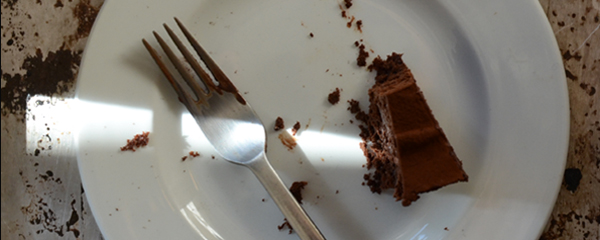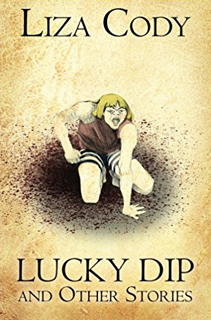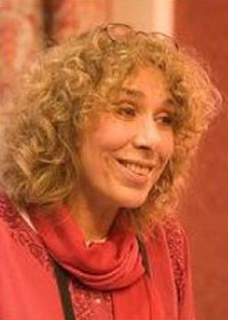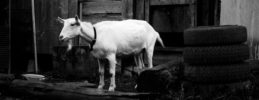
('Remains' © Serafin, 2011)
CHALK MOTHER
by HANNAH BROCKBANK
After tormenting myself about all the things I’ve done wrong in my life, I start to wonder why it is I’ve woken up. Did I leave the car lights on? Do I now have a flat battery? How will I get the children to school? Is World Book Day today or tomorrow? Does my daughter need a costume? Yes. That’s it. I’ve forgotten to make her a costume.
I go downstairs. Instead of using this extra time to whip up a Little Red Riding Hood cape from the Christmas tablecloth, I sit at my desk and pick up a book of short stories. It’s a library book and the laminated cover creaks and cracks loudly as I flex its spine. This feels deeply illicit. I shouldn’t be doing this. There are more pressing things to do.
 I start to read ‘Chalk Mother’ from Lucky Dip and Other Stories by Liza Cody. The opening line reads: ‘On the morning of my daughter’s wedding day I woke up with a hangover.’ “What kind of mother is this?” I say loudly to the cat, who is almost certainly as perturbed as my husband by my moonlight antics. I read on. The narrator is a successful artist who retreats, both physically and emotionally, whenever possible to avoid the glare of responsibility:
I start to read ‘Chalk Mother’ from Lucky Dip and Other Stories by Liza Cody. The opening line reads: ‘On the morning of my daughter’s wedding day I woke up with a hangover.’ “What kind of mother is this?” I say loudly to the cat, who is almost certainly as perturbed as my husband by my moonlight antics. I read on. The narrator is a successful artist who retreats, both physically and emotionally, whenever possible to avoid the glare of responsibility:
I sprawled like a washed-up starfish on the daybed in the studio, squinting furiously at the good north light. Day was an unwelcome visitor knocking at the window with the worst of bad news.
“Go away,” I said. But it didn’t.
The night before the wedding is reserved, by rights, for the bridegroom to behave badly, not the bride’s mother. But the bridegroom was too sensible. There was no rude, crude stag party, no dying gasp for the bachelor.
My daughter phoned me at seven in the evening and said, “Everything’s ready, Mum. Davey and I made the vol-au-vent cases. All we have to do in the morning is fill them.”
The conflict you might expect to exist between the seemingly self-indulgent mother and responsible daughter is, however, not evident. The daughter appears to be complicit, or at least peacefully resigned, to her mother’s seemingly irresponsible nature, which from the outset is intriguing. Further character contrasts between the narrator, her daughter, Davey, and Davey’s mother is evident in the dialogue:
“What’s Davey up to?” I said.
“He’s icing the chocolate gateau,” she said. “He doesn’t like wedding cake so we made a sort of multi-layered sacher torte. Davey’s mother thinks we’re crazy.” She giggled gently at their craziness.
“No stag party then?” I said to deflect her from the madness of chocolate icing.
The daughter is organised and sensible. Davey’s mother, we can deduce, is more of a traditionalist, regarding the choice of chocolate wedding cake as somewhat subversive. The narrator, as illustrated by her gently sarcastic off-topic reply, is reluctant to engage in a discussion about the wedding cake at all. The narrator is consistently at odds with other people around her and this is echoed throughout.
The story progresses through a series of flashbacks that lend a fuller understanding of the narrator’s personal traits. The careful revealing of backstory allows the plot to gain momentum, and provides close insight into a complex mother-daughter relationship. The narrator’s first flashback elucidates her daughter’s conception and early years. Cultural and historical references – such as the ‘Red Buddha Theatre’ and ‘Greenham Common’ – carry us back to the 1970s and early ’80s. They convey a time of footloose escapades and a social environment that is both vibrant and bohemian:
My daughter. Conceived somewhere on the road to Marrakesh, by someone enchanting whose name I never knew. My daughter who danced in my belly to Bedouin music. Who sat on my shoulders at the Stones concert in the park. Who slept in my lap at the Round House while the Red Buddha Theatre performed. Who sulked in the rain at Greenham Common.
Unlike the narrator, the daughter is not as free-spirited. She seeks the constancy of a stable life and does not appreciate her mother’s desire for spontaneous living.
It would be easy to dismiss the narrator as an uncaring mother who is disinterested in her daughter’s needs and wants, but that would be too simplistic. The narrator is acutely self-aware; an awareness that extends both to other people and to her physical environment. This is strikingly illustrated in her image-rich flashback to a trip she and her daughter took to New York:
When she was eleven I took her to the opening of my first exhibition in New York. There was snow on the ground. The air sparkled and cab door-handles tingled with dry electricity. She adored the Radio City Christmas pageant but she spent the whole week worried about missing school.
The environment crackles with connection and purpose but the daughter cannot fully be part of it. Instead, she frets about missing school. This important image transcends physical description and shows us what makes the narrator tick and what situations allow her to connect with the world.
On their return from New York, the narrator’s mother warns her that her daughter ‘…needs stability’ and that she is ‘…at that insecure age’. The narrator candidly reveals that she ‘…couldn’t deny it’. This blunt realisation is a short-lived surprise, as the narrator continues to leave for another exhibition, despite protests from her mother and daughter. The narrator is incorrigible and consistently driven by her urge for an independent life.
There are moments of intense tenderness but these are often tinged with a sense of failure:
My daughter has eyelashes like the highest quality sable brushes, like a fringe of soft fern around a deep blue pond. I cannot paint her eyes. I tried several times but I have always failed.
Ey es are a significant and recurrent theme throughout the story. Unlike her mother and daughter, who both have ‘beautiful cobalt blue eyes’, the narrator only comes close to their blueness when she accidentally pokes her ‘…eyebrow with finest hog’s hair bristles loaded with French ultramarine’. She will never be like her responsible mother or daughter. She will never see life as they do.
es are a significant and recurrent theme throughout the story. Unlike her mother and daughter, who both have ‘beautiful cobalt blue eyes’, the narrator only comes close to their blueness when she accidentally pokes her ‘…eyebrow with finest hog’s hair bristles loaded with French ultramarine’. She will never be like her responsible mother or daughter. She will never see life as they do.
Up until now, the story has intentionally focused on the daughter’s behavioural responses to the narrator’s actions. This focus, however, is misleading and deflects from the true emotional conflict, which resides within the narrator. The use of deflection emphasises the narrator’s discomfort in facing her own impending emotional and social transformation. It is not that the narrator has been unreliable: she has not concealed, she has simply observed and retold with apparently honest intent, the unhappy times and the painful realisations. She observes that her daughter:
…has taken great comfort over the years from the notion that I am eccentric, artistic and incapable of rational behaviour. She is normal – I am weird. She is steady – I am erratic. She is practical – I am… No. Not romantic. She is romantic, and if she is romantic I must be, of necessity, something else. She has defined herself, and in doing so she has defined me as her opposite. Black and white. Chalk and cheese.
As the title ‘Chalk Mother’ suggests, the story is one of contrast: ‘Chalk mothers buy clothes at Marks and Spencer, not Oxfam. Chalk mothers have husbands, not lovers.’ By employing the well-known idiom ‘chalk and cheese’, we are asked to consider how we align ourselves, or not, with others. Are we chalk, or are we cheese? Or are we neither of those? It is here that the story reaches its climax and we begin to see the bigger truth – a narrator who is forced to face her transformation:
“What?” my daughter says. “You’re mumbling. Have you been smoking? Don’t smoke, Mum, it isn’t good for you, and I don’t want Davey to think his mother-in-law is just an old hippy.”
That hurt. ‘Old hippy’ I could just about take. But ‘Davey’s mother-in-law’? That hit hard. Davey’s mother-in-law wasn’t me. Davey’s mother-in-law was a stranger with a stern face and cheap reading glasses bought on the spur of the moment from a late-night chemist.
Towards the end of the story, the narrator gets dressed for the wedding in an outfit her daughter bought for her:
She chose silk the colour of newborn moss, and I wasn’t offended. I like silk, and I like moss. My daughter would be wearing silk too: silk the colour of buttermilk.
There is a sense of harmony, they are both dressed in silk, and the colour ‘newborn moss’ suggests the narrator may be on the cusp of accepting her new role as Davey’s mother-in-law. It becomes apparent, however, through the narrator’s final poignant action in the penultimate paragraph, that she cannot totally conform, and for this, I am truly grateful.
As I hear the sleepy stirrings of my daughter in the room above, the clunk of her hot water bottle hitting the floor, the whine of her wardrobe door opening, I do not get up from my ink stained desk. I do not set the breakfast table. Instead, I sit and try to remember a time when reading did not feel like an indulgence. I wonder how my daughter feels about the space I need from her to write and I wonder if she knows how guilty I feel when I do. And then I wonder, if it might be possible, to make the red cape before school after all.
~
 Hannah Brockbank is joint winner of the 2016 Kate Betts’ Memorial Prize. Recent publications featuring her work include Hallelujah for 50ft Women Anthology (Bloodaxe), The London Magazine and Envoi. Her poems also featured in the Chalk Poets Anthology as part of the 2016 Winchester Poetry Festival. Her first pamphlet, Bloodlines, is due for publication by Indigo Dreams Publishing in 2017. She is studying for a PhD at the University of Chichester.
Hannah Brockbank is joint winner of the 2016 Kate Betts’ Memorial Prize. Recent publications featuring her work include Hallelujah for 50ft Women Anthology (Bloodaxe), The London Magazine and Envoi. Her poems also featured in the Chalk Poets Anthology as part of the 2016 Winchester Poetry Festival. Her first pamphlet, Bloodlines, is due for publication by Indigo Dreams Publishing in 2017. She is studying for a PhD at the University of Chichester.
Twitter @hannahbrockbank
Website www.hannahbrockbank.com
Author photograph by Natalie Miller

